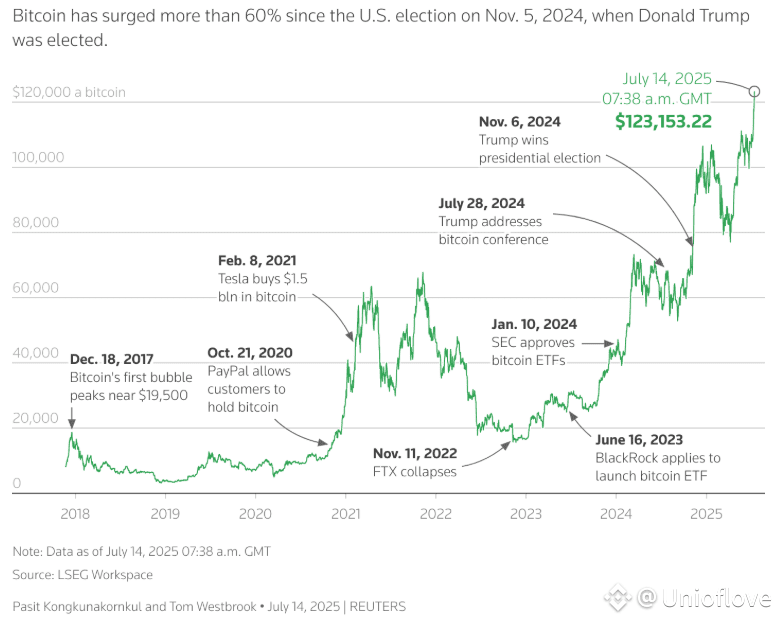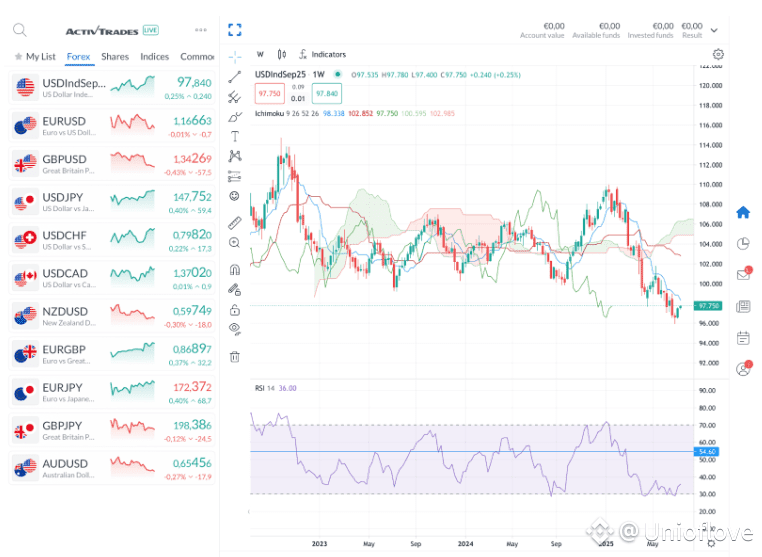The House of Representatives is set to consider three bills that could overhaul U.S. crypto policy, a development that has propelled Bitcoin to a new record high above $123,000. Other digital coins climbed yesterday, pushing the market cap of the industry to about $3.8 trillion. Let’s take a close look at the reasons behind the move and how far could Bitcoin go for the rest of 2025.
How far can Bitcoin go for the rest of 2025?#USCryptoWeek
Bitcoin's recent surge past the $123,000 mark highlights just how quickly sentiment can shift in favor of digital assets—especially when regulatory clarity and macroeconomic forces align. This latest rally, part of a broader upward trend that has seen the cryptocurrency set multiple all-time highs in recent weeks, is being driven by a confluence of political, economic, and structural factors. Legislative progress in Washington, a weakening U.S. dollar, rising inflation concerns, and shifting investor perceptions around alternative stores of value are all contributing to Bitcoin’s renewed appeal.#BTCWhaleTracker
Yet while the short-term backdrop appears bullish, the road ahead is far from certain. Bitcoin remains inherently volatile, often mirroring the behavior of high-risk assets like tech stocks—albeit with significantly greater magnitude. That volatility is both a challenge and a feature: it can drive dramatic upside but also sharp corrections, especially in response to changes in policy, regulation, or investor sentiment.
So far in 2025, bitcoin outperformed nearly every major asset class. It's up nearly 29% year-to-date, second only to gold, which has risen around 28%. For comparison, the tech-heavy Nasdaq 100 has gained almost 9%, while the S&P 500 is up about 7%. However, most of Bitcoin’s gains have come in just the last few weeks—underscoring the asset's tendency to move in powerful, concentrated bursts.
Behind that momentum lies more than just enthusiasm for crypto. President Donald Trump’s trade war, combined with his administration’s latest tax cut and spending package, has not only increased the fiscal deficit but also raised expectations of looser monetary conditions—both of which have historically been bullish for Bitcoin and other inflation-sensitive assets.#MemecoinSentiment
Still, the sustainability of this rally will depend on several factors. The final language and fate of the three major crypto bills—GENIUS, CLARITY, and the Anti-CBDC Act—will play a critical role in shaping the industry's path forward. Institutional adoption, investor risk appetite, inflation data, and global central bank policies will also weigh heavily on performance through the second half of the year.
For now, though, one thing is clear: after years of regulatory uncertainty and political indifference, crypto has arrived at the center of the U.S. financial policy conversation. That shift represents not just a near-term trading catalyst—but potentially a long-term structural turning point for Bitcoin and the digital asset ecosystem at large.
Whether this is the start of a sustained breakout or just another chapter in Bitcoin’s boom-and-bust history remains to be seen. But one thing is certain: 2025 is shaping up to be a defining year for crypto. What do you think?
Stay up to date with @Unioflove moving and shaking on the world's markets and never miss another important headline again!


'Crypto week' on Capitol Hill and weak US Dollar: Why Bitcoin cleared $123,000
Bitcoin’s push through the $123,000 mark on Monday did not occur in a vacuum. The jump coincides with what Republicans have dubbed “crypto week,” a stretch in which the House of Representatives is scheduled to debate—and potentially pass—three landmark measures: the GENIUS Act, the CLARITY Act and the Anti‑CBDC Surveillance State Act. Each addresses a critical regulatory gap that has long weighed on digital‑asset valuations and together, they have brightened the near‑term outlook for the entire asset class.
1. Genius Act: Stablecoin standards that deepen market liquidity
By proposing federally recognized rules for dollar‑backed stablecoins—mandatory 1:1 reserves, monthly public disclosures and tight definitions of eligible collateral—the Genius Act would place the sector on a footing banks, retailers and payment processors can trust. Because stablecoins serve as the principal bridge between fiat currency and crypto markets, clearer standards promise deeper dollar liquidity, smoother trading and lower counter‑party risk—conditions that invariably support Bitcoin’s price discovery.#ArbitrageTradingStrategy
2. Clarity Act: A primary‑market roadmap that unlocks institutional demand
The Clarity Act would hand the Commodity Futures Trading Commission primary oversight of “digital commodities” (i.e., most cryptocurrencies) while carving out a narrowly defined role for the SEC in fundraising transactions. By delineating when a token is a security and when it is not, the bill tackles the biggest hurdle facing pension funds, insurers and other regulated institutions: uncertainty. If enacted, many sidelined allocators could treat Bitcoin and large‑cap tokens as investible assets, broaden the buyer base and support valuations.#ETHBreaks3k
3. Anti‑CBDC surveillance state act: Pro‑privacy signaling that reinforces the decentralization case
This measure would bar U.S. regulators from launching a retail central‑bank digital currency. Although a CBDC is conceptually separate from Bitcoin, banning one removes a perceived competitor while signaling that Washington is willing to protect financial privacy and free‑market money solutions. That stance strengthens the narrative that decentralized assets such as Bitcoin remain essential alternatives to state‑controlled payment rails.
4. A weakening Dollar adds fuel to Bitcoin’s breakout
While policy developments on Capitol Hill are certainly helping drive momentum, Bitcoin’s rise past $123,000 is also being supported by a sharp decline in the U.S. dollar. Over the first half of 2025, the dollar has fallen more than 10% against a basket of major developed-market currencies, and nearly 13% versus the euro alone.
This depreciation has made Bitcoin more appealing to international investors looking for a hedge against further weakening of the greenback and long-term changes to its status as the world’s dominant reserve currency.
The dollar’s fall boosts the value of risk assets like equities and crypto, which are priced in dollars. It’s no coincidence that while Bitcoin reached a record high in USD terms, it has not yet broken new ground when priced in other benchmarks such as the Euro or the British pound (or even other assets like gold, or major stock indices). This suggests that the breakout is, at least in part, a currency effect—a shift in the denominator rather than the numerator.
In other words, Bitcoin’s new highs may reflect not just enthusiasm for the crypto space, but also skepticism about the dollar’s long-term strength and role in global finance. With the U.S. Dollar Index (DXY) recently hitting its lowest levels since February 2022, this macro backdrop is likely reinforcing bullish sentiment, especially among non-U.S. investors who view Bitcoin as a decentralized hedge in an increasingly unstable monetary environment. 👍👍👍👍👻



